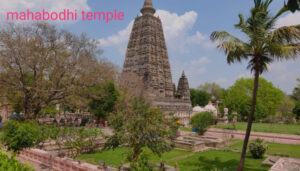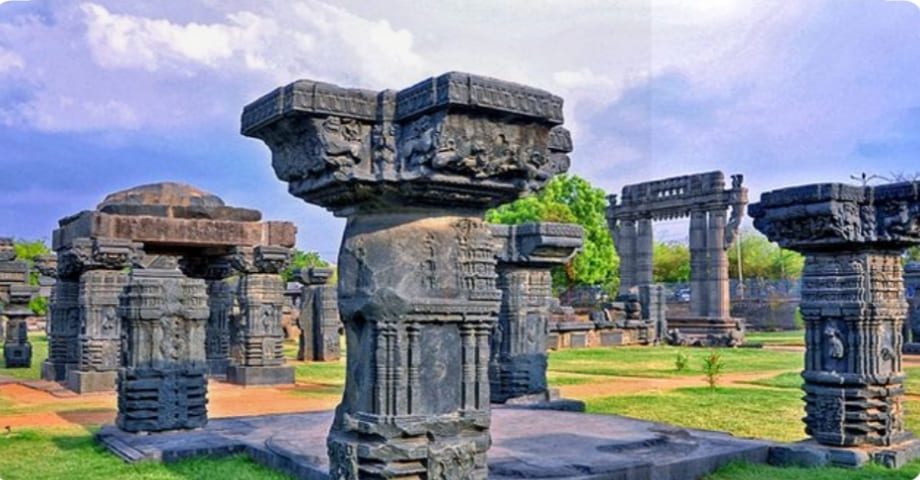The Mahabodhi Temple in Bodh Gaya, Bihar, India, stands as one of the most revered pilgrimage sites for Buddhists around the world. This ancient temple, deeply rooted in history and spirituality, marks the location where Siddhartha Gautama, later known as the Buddha, attained enlightenment. Recognized as a UNESCO World Heritage Site, the Mahabodhi Temple is not only a symbol of Buddhist faith but also an architectural marvel that draws thousands of visitors each year.

1.Historical Background of Mahabodhi Temple
•Origins and Construction
The origins of the Mahabodhi Temple trace back to the 3rd century BCE when Emperor Ashoka, a devout follower of Buddhism, is believed to have constructed the first temple at the site. Ashoka’s contribution to Buddhism is monumental, and the Mahabodhi Temple is one of the many legacies he left behind. The temple has undergone several renovations and expansions over the centuries, reflecting the various cultural and architectural influences that have shaped its current form.
2. Mahabodhi Temple:Architectural Style and Featur
The Mahabodhi Temple showcases a blend of Dravidian architecture and early Buddhist design elements. The central tower of the temple, which rises to a height of 50 meters, is one of its most striking features. The tower is surrounded by smaller stupas and shrines, each intricately carved with depictions of the Buddha and scenes from his life. One of the most sacred spots within the temple complex is the Bodhi Tree, under which Buddha is said to have meditated and achieved enlightenment.
3. Mahabodhi Temple: Preservation and Renovation Efforts
The temple has faced various challenges over the centuries, including periods of neglect and damage. However, efforts to preserve and restore the Mahabodhi Temple have been ongoing. The British undertook significant restoration work in the 19th century, and today, the temple is carefully maintained by various Buddhist organizations and the Indian government. These efforts ensure that the temple remains a place of spiritual significance for future generations.

4.Religious Significance of Mahabodhi Temple
• The Bodhi Tree
At the heart of the Mahabodhi Temple complex is the Bodhi Tree, a direct descendant of the original tree under which Buddha attained enlightenment. For Buddhists, the Bodhi Tree is a living symbol of Buddha’s journey towards spiritual awakening. Pilgrims from around the world come to meditate under its shade, seeking inspiration and spiritual guidance.
• Daily Rituals and Pilgrimages
The Mahabodhi Temple is a major pilgrimage site for Buddhists, attracting visitors from across the globe. Daily rituals at the temple include chanting, meditation, and offering prayers. Monks and laypersons alike come to pay their respects, often circumnavigating the temple in silent reflection. The act of pilgrimage to the Mahabodhi Temple is seen as a way to purify the mind and draw closer to the teachings of Buddha.
• Festivals and Celebrations
The Mahabodhi Temple is also the focal point for several important Buddhist festivals, the most significant being Buddha Purnima, which celebrates the birth, enlightenment, and death of Buddha. During these festivals, the temple complex is adorned with lights and decorations, and the air is filled with the sounds of chanting and prayers. Pilgrims gather in large numbers to participate in these events, making it a time of communal harmony and spiritual upliftment.
5.Architectural Marvel of Mahabodhi Temple
• Detailed Analysis of the Temple’s Design
The Mahabodhi Temple’s architectural design is both symmetrical and symbolic, representing the spiritual path towards enlightenment. The temple’s main structure is shaped like a pyramid, with the central spire symbolizing the ascent towards higher consciousness. The temple’s walls are adorned with intricate carvings depicting various aspects of Buddha’s life, as well as motifs that represent the universal truths of Buddhism.
• Surrounding Monasteries and Shrines
Surrounding the Mahabodhi Temple are several monasteries and shrines that represent different Buddhist traditions from around the world. These include monasteries from countries such as Thailand, Japan, and Sri Lanka, each contributing to the global nature of the temple complex. These monasteries serve as centers for study, meditation, and the practice of Buddhist teachings, further enriching the spiritual atmosphere of the Mahabodhi Temple.
• The Maha Bodhi Society
The Maha Bodhi Society, established in the late 19th century, plays a crucial role in managing and preserving the Mahabodhi Temple. The society was instrumental in reviving Buddhist pilgrimage to Bodh Gaya and continues to support the temple’s maintenance and the dissemination of Buddhist teachings worldwide. The work of the Maha Bodhi Society ensures that the Mahabodhi Temple remains a vital part of the global Buddhist community.
6.Visiting the Mahabodhi Temple
• How to Reach Bodh Gaya
Bodh Gaya is well-connected by road, rail, and air, making it accessible to visitors from across India and beyond. The nearest airport is in Gaya, approximately 17 kilometers from the temple, while the closest major railway station is also in Gaya. Regular bus services and taxis are available from Gaya to Bodh Gaya, ensuring a smooth journey for pilgrims and tourists alike. The best time to visit the Mahabodhi Temple is during the cooler months, from October to March, when the weather is pleasant and conducive to exploring the temple complex.
• What to Expect During the Visit
Visitors to the Mahabodhi Temple can expect a serene and spiritually enriching experience. The temple is open to visitors from early morning until evening, with no entry fee. However, there are guidelines to be followed, such as dressing modestly and maintaining silence within the temple premises. Photography is allowed in certain areas, but it is important to respect the sanctity of the site. The temple complex is wheelchair accessible, and facilities for meditation and study are available for those interested.
• Nearby Attractions
In addition to the Mahabodhi Temple, Bodh Gaya is home to several other important Buddhist sites. The Great Buddha Statue, a towering figure that stands 25 meters high, is located nearby and is a popular attraction. The Sujata Kuti, a small temple dedicated to Sujata, the woman who offered Buddha his first meal after enlightenment, is another site worth visiting. These attractions, along with the peaceful ambiance of Bodh Gaya, make it a must-visit destination for those interested in Buddhism and spiritual exploration.
Conclusion:
The Mahabodhi Temple is more than just a historical monument; it is a living symbol of peace, enlightenment, and the enduring legacy of Buddha’s teachings. Its cultural, religious, and architectural significance make it one of the most important pilgrimage sites in the world. Whether you are a devout Buddhist or a traveler seeking spiritual solace, a visit to the Mahabodhi Temple offers a unique opportunity to connect with the essence of Buddhism and experience the tranquility that emanates from this sacred site.
FAQs:
1.What is special about Mahabodhi Temple?
2.Who built first Mahabodhi Temple?
3.Who destroyed the Mahabodhi Temple?
4.Why is Bodh Gaya temple famous?
5.Mahabodhi Temple is located in which state
6.Mahabodhi Temple Wikipedia
7.Mahabodhi Temple history
8.5 lines on Mahabodhi Temple
9.Mahabodhi Temple architecture style
10.Mahabodhi Temple built by which dynasty

